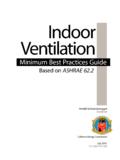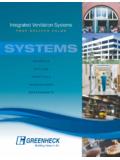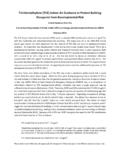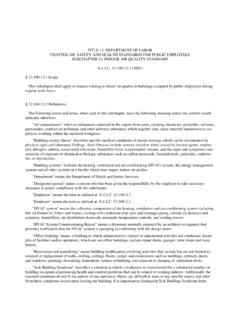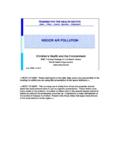Transcription of ASHRAE Journal Ventilation - Mobile Calibration …
1 ASHRAE Journal Ventilation Ventilation for Enclosed Parking Garages By Moncef Krarti, , , and Arselene Ayari, indication of risks from exposure to CO. Member ASHRAE . A. in parking garages. A limit of 25 ppm for long-term CO exposure would meet al- utomobile parking garages can be partially open or fully enclosed. most every code and standards listed in Table 1. Partially open garages are typically above-grade with open sides The Ventilation rate requirements rec- and generally do not need mechanical Ventilation . However, fully ommended by ASHRAE and other codes are independent of the characteristics of enclosed parking garages are usually underground and require mechanical the parking garage and do not consider Ventilation . Indeed, in the absence of Ventilation , enclosed parking facilities the various parameters that may affect indoor air quality, such as the emission present several indoor air quality problems.
2 The most serious is the emis- generation rate and the acceptable pol- sion of high levels of carbon monoxide (CO) by cars within the parking lutant level. A new design method is needed to determine the Ventilation rate garages. Other concerns related to enclosed garages are the presence of oil required for a wide range of enclosed park- and gasoline fumes, and other contaminants such as oxides of nitrogen (NOx) ing garages. This design method should be flexible to accommodate not only the and smoke haze from diesel engines. various CO exposure limits defined by the To determine the adequate Ventilation is, a continuous monitoring of CO con- standards but also the changing emission rate for garages, two factors are typically centrations is conducted, with the moni- inventory from motor vehicles. considered: the number of cars in opera- toring system being interlocked with the tion and the emission quantities.
3 The num- mechanical exhaust equipment. The ac- Field Testing Results ber of cars in operation depends on the ceptable level of contaminant concentra- As part of an ASHRAE -sponsored type of the facility served by the parking tions varies significantly from code to project (945-RP), field measurements for garage and may vary from 3% (in shop- code. A consensus on acceptable con- the seven tested parking facilities were ping areas) up to 20% (in sports stadi- taminant levels for enclosed parking ga- performed. The air change rates are mea- ums) of the total vehicle capacity. The rages is needed. sured using the tracer gas technique. First, emission of carbon monoxide depends on Unfortunately, Standard 62-1989 does the tracer gas (SF6) was injected in the individual cars including factors such as not address the issue of Ventilation con- building directly or through the supply the age of the car, the engine power, and trol through contaminant monitoring for fans.
4 Then, the concentration of the tracer the level of car maintenance. enclosed garages. Thus, ASHRAE com- gas was monitored using a field-portable For enclosed parking facilities, ANSI/ missioned a research project (945-RP) to electron capture gas chromatograph. For ASHRAE Standard 62-1989, Ventilation evaluate current Ventilation standards a more detailed description of the field for Acceptable Indoor Air Quality speci- and recommend rates appropriate to cur- measurements, see Reference 4. fies a fixed Ventilation rate of below rent vehicle emissions/usage. L/s m2 ( cfm/ft2) of gross floor About the Authors Therefore, a Ventilation flow of about Ventilation Regulation Moncef Krarti, , , is an air changes per hour is required for Table 1 provides a summary of exist- associate professor in the Civil, Envi- garages with m (8 ft) ceiling height.
5 Ing codes and standards for ventilating ronmental and Architectural Engineer- However, some of the model code au- enclosed parking garages in the Unites ing (CEAE) Department at the Univer- thorities specify an air change rate of four States, and other selected countries. As sity of Colorado at Boulder. He is a to six air changes per hour. In addition, shown in Table 1, the recommendations member of TC , Thermal Storage, some of the model code authorities allow for the CO exposure limits are not consis- and and TC , Energy Calculation. the Ventilation rate to vary and be re- tent between various regulations within Arselene Ayari, , is a consult- duced to save fan energy if CO-demand the United States and other countries. ant engineer in indoor air quality and controlled Ventilation is performed, that However, the recommendations offer an control systems.
6 52 ASHRAE Journal February 2001. Ventilation tion of the supply fans. Time (hrs) PPM Ventilation Table 2 summarizes some of the results obtained during the field testing for seven From the field study, the 8 9 L/s m2. following results were ob- ASHRAE . garages described in Ayari, et al. (2000). 1 35 ( cfm/ft2). The ACH values present the range of the tained: 1. All the tested enclosed 8 50 L/s m2. air changes per hour measured at various ICBO. 1 200 ( cfm/ft2). locations of the facility using the tracer parking garages had con- gas technique, while the L/s m2 (cfm/ft2) taminant levels that are sig- NIOSH/ 8 35.. values provide the total Ventilation rate. nificantly lower than those OSHA Ceiling 200. The maximum and the average CO con- required by even the most centrations measured during the day of stringent regulations ( , 25 BOCA 6 ACH.)
7 Testing are listed in Table 2 to character- ppm of 8-hour weighted av- ize the indoor quality within the tested erage of CO concentration). SBCCI 6 7 ACH. parking facility. As indicated in Table 2, 2. The actual Ventilation the CO level within all the parking garages rates supplied to the tested garages were generally well NFPA 6 ACH. never exceeded 35 ppm even though the Ventilation rates in all cases is well below below those recommended the L/s m2 ( cfm/ft2) recommended by Standard 62-1989 ( , ACGIH 8 25 . by Standard 62-1989. The only garage below L/s m 2 [ that has a Ventilation rate close to cfm/ft2]). 8 11/13. Canada . L/s m2 ( cfm/ft2) is Garage E, which 3. When it is used, de- 1 25/30. serves a large shopping mall with heavy mand controlled Ventilation 8 30 L/s m2. was able to maintain ac- Finland usage throughout the day.
8 It should be 15 minutes 75 ( cfm/ft2). noted that all the garages are ventilated ceptable indoor air quality within the tested enclosed Ceiling 200 165 L/s car continuously except Garage B, where CO France 20 minutes 100 (350 cfm/car). sensors were used to control the opera- parking facilities. 4. The location of supply L/s m2. Germany . and exhaust vents, traffic ( cfm/ft2). flow pattern, the number of Japan/South L/s m2. moving cars, and travel Korea . ( cfm/ft2). time were important factors that affect the effectiveness Netherlands 200 . of the Ventilation system in maintaining acceptable CO L/s m2. (or NOx) levels within en- Sweden . ( cfm/ft2). closed parking garages. Any design guidelines 8 50. 6 10 ACH. 15 minutes 300. should account for these factors to determine the Table 1: Summary of and international stan- Ventilation requirements for dards for Ventilation requirements of enclosed park- Advertisement in print edition enclosed parking facilities.
9 Ing garages. previously in this space. It is clear from the results of the field study that the current ventila- metric analyses, 4 a simple design method tion rate specified in Standard 62-1989 is was developed to determine the ventila- outdated for enclosed parking garages. tion flow rate required to maintain accept- New design guidelines are needed to pro- able CO level within enclosed parking fa- vide the minimum Ventilation rate required cilities. Ventilation rates for enclosed park- to maintain contaminant concentrations ing garages can be expressed in terms of within parking facilities at the acceptable either flow rate per unit floor area (L/s m2. levels set by the relevant health authori- or cfm/ft2) or air volume changes per unit ties without large penalties in fan energy time (ACH). The design Ventilation rate use.
10 Guidelines should account for vari- required for an enclosed parking facility ability in the parking garage traffic flow, depends on four factors: car emissions, travel time, and number of 1. Contaminant level acceptable within moving cars. the parking facility;. 2. Number of cars in operation during Design Approach peak conditions;. Based on the results of several para- 3. Length of travel and operation time February 2001 ASHRAE Journal 53. ASHRAE Journal of cars in the parking garage; and, 2. Normalize the value of generation rate using a reference 4. Emission rate of a typical car under various conditions. value GRo= gr/hr m2 (GRo= gr/hr ft2). This reference value Data for these factors should be available to determine accu- was obtained using the worst emission conditions (cold emis- rately the design Ventilation rate for enclosed parking garages.)
